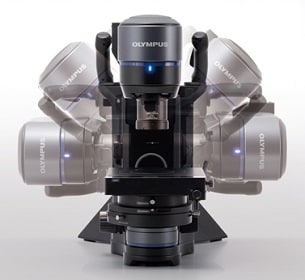The New Olympus DSX1000 Digital Microscope Greatly Improves Inspection and Analysis Speed The Microscope Boasts a 20–7,000X Magnification Range and the Ability Instantly Switch Between 6 Observation Methods
June 3, 2019

DSX 1000 Digital Microscope
Olympus Corporation (Representative Director and President: Yasuo Takeuchi) announced the global launch of the DSX1000 digital microscope, which significantly improves users’ inspection workflow and enables the analysis of a wide variety of samples with a single tool. This new product from Olympus’ Scientific Solutions business was launched worldwide on June 3, 2019.
DSX series digital microscopes combine the quality of our renowned optical technologies with the ease of use of digital technologies. The DSX1000 digital microscope is used to observe and measure a variety of samples, including electronic components and metal materials. The microscope requires little training to use; simply place your sample and easily perform a series of operations from 3D observation to measurement and reporting.
The DSX1000 microscope meets a wide range of observational and analytical needs in a single unit while improving the inspection workflow. An expanded lineup of 15 lenses covers a 20-7,000X magnification range. Users can also take advantage of the microscope’s six observation methods to observe and measure a variety of objects. For example, techniques are available to highlight irregularities on a sample surface or emphasize contours. The main unit and stage can each be freely adjusted ± 90° to accommodate samples with many shapes and to view the samples from all angles. In addition, newly developed algorithms can be used to acquire 3D images approximately ten times faster than conventional digital microscopes. Lastly, we support efficient and accurate observations and analyses by calibrating microscopes for each user’s operating environment to help ensure accurate measurements.
Main Features
- 20–7,000X magnification range and a rotating stage.
- Immediately switch between objective lenses and six observation methods.
- Telecentric optical system provides guaranteed measurement accuracy throughout the magnification range.1
Details of Main Features
1. 20–7,000X magnification range and a rotating stage.
Five new objective lenses are available for the DSX1000 digital microscope, bringing the total up to 15. The 20-7,000X magnification range enables precise observation, while long working distance objectives make it possible to observe irregular samples, such as electronic boards and machined components. The main unit and stage can rotate ± 90°, making it easier to view and analyze thin samples, such as wafers, or large parts, like automotive components.

A comparison of wafer images at 20–7,000X.

Adaptable body and stage
The main unit and stage can be rotated ± 90° respectively.

Using a high-resolution long working objective lens
The long working distance enables users to observe electronic substrates with irregularities.
2. Immediately switch between objective lenses and six observation methods.
The electric zoom head incorporates advanced observational functions, enabling the use of six observation methods and contrast UP functions: brightfield, darkfield, MIX, polarizing, simple polarizing and differential interference contrast. The polarization observation and contrast UP functions can highlight the irregularities and contours of a sample surface. This functionality is used, for example, to instantly switch between observing debris and scratches to larger irregularities on a wafer’s surface. This allows the user to observe objects that are otherwise difficult to detect.

A comparison of solar cells (left: brightfield observation, right: polarization observation)
The surface irregularities are emphasized by irradiation of light from one side. This technique is suitable for observing irregularities, twisted samples, and notches.

A comparison of images of an integrated circuit (IC) chip (left: normal, right: with the contrast UP function)
A sharper, brighter image is obtained to represent the bright and dark parts.
3. Telecentric optical system provides guaranteed measurement accuracy throughout the magnification range.
Manufacturers of automobiles, precision equipment and other products are required to accurately measure and analyze product specifications to demonstrate safety. The DSX1000 digital microscope uses a telecentric optical system with low distortion throughout the magnification range, enabling high-precision measurement with guaranteed accuracy and repeatability. To help ensure accuracy, an Olympus technician calibrates each DSX1000 microscope after it has been installed in the customer’s usage environment.

Comparing images captures with and without a telecentric optical system
Changing the focus position does not change the image size.
1 Calibration must be performed by Olympus.
For more information
Press releases are company announcements that are directed at the news media.
Information posted on this site is current and accurate only at the time of their original publication date, and may now be outdated or inaccurate.

